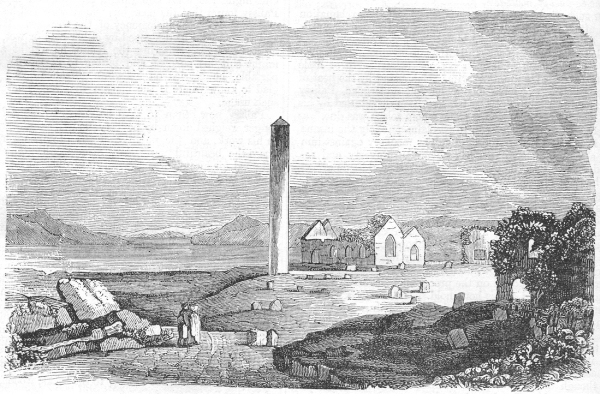Iniscattery Island and Round Tower, County Clare
From The Illustrated Dublin Journal, Volume 1, Number 32, April 12, 1862

INISCATTERY, or the Island of Scattery, near the mouth of
"The spacious Senan [Shannon] spreading like a sea,"
has been styled in an Irish MS., called the Book of Ballimote, "the wonder of Ireland." And well it may, if we are to credit the legend which Mr. Moore has followed in his version of the dialogue between St. Senanus and the lady who sought his holy isle, in a vessel guided by an angel,
"Through wintry winds and billows dark," and was Inhospitably repelled.
Connected with the former sanctity of Iniscattery, the most remarkable object at present is the Round Tower represented in the annexed engraving. This tower is an important land-mark in the navigation of the Shannon, and it is also probably the most ancient building upon the island. It is said to measure one hundred and twenty feet in height, and springs from a base twenty-two feet in circumference. Although scathed and rent by lightning, the original roof remains. While its fellow pillar-towers, as at Kildare and Cloyne, have been compelled to assume embattlements, that of Iniscattery retains its primitive covering, and stands proudly crowned with that barrad, or conical cap, which, according to Walker, the national architects and sculptors of Ireland regarded as a dress becoming even to angels.
Although it has been asserted that eleven churches were built upon the island by Senanus, the remains of seven churches or cells only are to be traced; from a glance at which it is evident to the eye of the architectural antiquary, that the date of the building of three of these ruins must have been long subsequent to the days of the ungallant saint. "The cathedral, (which is seen in the engraving, close to the Round Tower), St. Mary's church, and one other," observes a modern pilgrim to Scattery, "are in pointed style, but possess no particular attraction. The neighbourhood of the latter is used as a burying ground, and the interior of the cathedral has been cleared away and converted by the irreverent islanders into a ball-alley." Three more ancient structures, "one of them called Simon's own, stand in the north-west of the cathedral, the largest of which is but twenty-two feet long, and the smallest twelve, and of proportionate breadth. Teampul an eird, that is, the church of the height, is of similar dimensions, and equally unadorned. The light was admitted into each of these Lilliputian temples by one or two very small windows, little superior to loop-holes; so narrow, that, when entirely open, we must be struck with surprise, how the light which they admitted could have sufficed."
In a memoir for the reformation of Munster, which was drawn up for the information of the English government, in the reign of Henry VIII., by Edmund Sexton, who was Mayor of Limerick in 1535, and who had previously distinguished himself by his efforts to advance the English interest in Ireland, Iniscattery is described as an island within the mouth of the Shannon, distant eight miles from Loop-head, at the northern entrance of that river. Upon the island the merchants of Limerick dwelt, and had castles and stone houses of their own inheritance, "with a provost, or warden, who might dispend a hundred marks yearly." He recommends the place as a proper situation for a fortress, which, with one ship of sixty tons and two or three galleys, would keep O'Brien, Desmond, (that is to say their countries, the present counties of Clare, Limerick, Kerry, and Cork,) and all the Irish from Waterford to Galway in awe.
